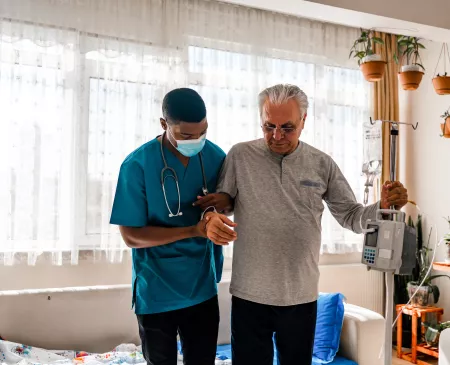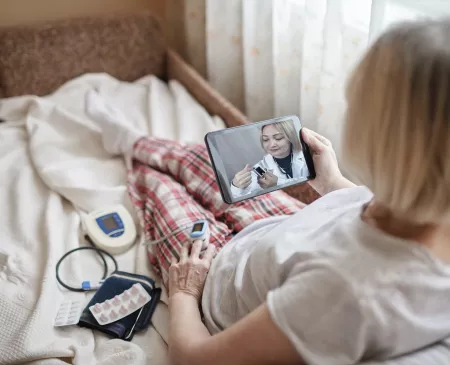When done right, hospital at home (also known as acute care at home) has significant benefits for patients and health systems, care teams, and workforces alike. This burgeoning care delivery model has been shown to reduce readmission rates and costs while increasing satisfaction among clinicians, patients, and family caregivers. 1, 2, 3
Many hospital at home programs are struggling to generate the energy needed to move beyond a pilot to a core competency across the clinical enterprise. When an organization’s financials, clinical care approach, and operating models are sound, what’s inhibiting growth? A lack of purposeful communication and meaningful stakeholder engagement to drive change could be your Achilles heel.
Leverage Change Management and Strategic Communications to Activate Your Collective Power
Communications and change management disciplines are crucial to successful organizational transformation. Because hospital at home programs require a fundamental shift in how the entire care team and patients think about and experience acute care, an intentional communication and change management campaign is non-negotiable to overcome the comfort of the status quo.
Hospital at home programs deploy the expertise, resources, and competencies needed to open up brick-and-mortar hospitals in fundamentally new and different ways. These organizations are large and complex, made up of thousands of individuals—each with unique abilities, experiences, motivations, challenges, and more. To truly activate the power of the collective in this paradigmatic shift, it is critical to appreciate the rich mosaic of the organization and direct energy to building champions while muting the effects of detractors.
4 Fundamental Communications and Change Management Principles for Accelerating Hospital at Home
Consider these fundamental principles when launching or accelerating your hospital at home program:
1. Articulate a Compelling Vision and Case for Change
Define and share your organization’s specific case for change and your vision for the future. This should serve as your North Star—the foundational message for all stakeholders. Without awareness and a clear understanding of what you’re driving toward, your leaders, physicians, and employees will hesitate to adopt change.
A compelling, motivating case for change is rooted in evidence and brought to life through storytelling. It likely encompasses everything from how it unlocks acute care capacity to how it improves the lives of your patients with a convenient home-based care option to how it supports your organization’s mission.
What this looks like in action: Hold a visioning workshop with your clinical, operational, and administrative leaders to align on a shared definition for your organization’s vision for hospital at home. With the right partners at the table early on, leverage the power of communications to translate that vision to stakeholders across the organization, including enabling physicians (e.g., hospitalists and emergency medicine physicians), the rest of your provider community, all team members and—at the right time—patients and their families.
2. Meet People Where They Are
A strong organizational vision is important, but not enough to motivate stakeholders to embrace new ways of thinking and doing. Successful hospital at home programs require buy-in, support, and proactive participation from almost every facet of the organization. Success lies in part with the ability to translate the organization’s vision for its hospital at home program to each of its stakeholder groups in a way that connects to why they should care and what’s in it for them. This requires a deep understanding and appreciation of what motivates your people—from both an individual and group perspective.
For example, your hospitalists and emergency medicine physicians will have different motivators or concerns with this new care delivery model. Understanding each audience who will be critical to building a scalable and economically sound program—and what matters to them—is a must. You can gain that understanding through intentional listening, reflecting back what you hear, and sharpening your message to resonate and motivate.
What this looks like in action: Complete detailed stakeholder mapping to better understand audiences who are enablers for growth and their current awareness of, perception of, and buy-in for hospital at home. Further inform your engagement approach and messaging through listening sessions to glean insights on individual and group motivators (e.g., lifestyle improvements and financial) concerns, and more. Use what you learn through these conversations to develop audience-specific messages, proof points and engagement tactics to garner support.
3. Secure Buy-In Through Collaboration
To be successful, collaborate, don’t dictate. Build formal avenues for collaboration through clear governance and decision-making models that involve key stakeholders in the design of your future state. Leverage that deep understanding of your stakeholders’ motivators and concerns to shape the program’s clinical and operating models, where appropriate. Commit to communicating often about how each stakeholder group’s expertise is shaping the work.
What this looks like in action: The insights you gather through concerted listening efforts can be applied beyond shaping communications and engagement strategies. Where possible, use what you’ve learned to involve a variety of voices in building your future state. For example, bring your physicians and advanced practice providers (APPs) to the table when developing your care team structure, and involve those closest to patient care in designing key workflows.
4. Leverage the Power of Storytelling, and Build Avenues for Meaningful Conversations
Appeal to people’s emotions and personal motivations through the power of storytelling. Patient, employee, and provider stories are compelling tools to display successes, bring stakeholders on board, and recognize individuals for their contributions. At the same time, recognize and jointly own improvement opportunities. Build formal feedback loops to promote a culture of sharing successes and problem-solving.
What this looks like in action: Stories motivate people to action. Highlight testimonials from patients who have experienced first-hand the benefits of this new care delivery model. Use both internal and external channels. Engage providers to share with their peers within your system how hospital at home has improved their patients’ lives. Constantly mine examples that point to the tangible benefits of what you’re building (i.e., improved patient and family experience, provider satisfaction, and better outcomes).
Accelerate Your Hospital at Home Program with Communications and Change Management Best Practices
Advancing a new care delivery model requires conviction and buy-in across the organization, from the highest levels of leadership to the clinicians closest to patient care and staff supporting care delivery. Empower your people through intentional, thoughtful communications and stakeholder engagement to drive meaningful change and adoption of your hospital at home program across the enterprise.
Additional contributors to this article:
Jon Freedman, Partner, and Mark Krivopal, MD, Senior Partner
© 2025 The Chartis Group, LLC. All rights reserved. This content draws on the research and experience of Chartis consultants and other sources. It is for general information purposes only and should not be used as a substitute for consultation with professional advisors.




